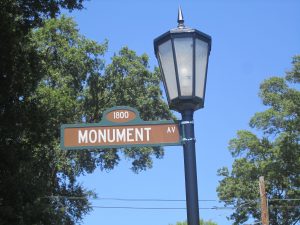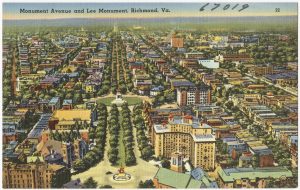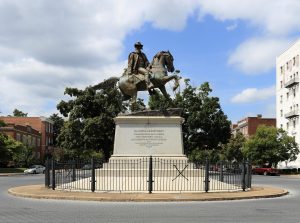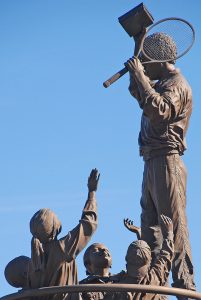 I’ve been following the debate over Monument Avenue with great interest. I was born and raised in Richmond, Virginia. I’ve lived in a few places since leaving home for graduate school, but Virginia is, and always will be home.
I’ve been following the debate over Monument Avenue with great interest. I was born and raised in Richmond, Virginia. I’ve lived in a few places since leaving home for graduate school, but Virginia is, and always will be home.
I’m proud of my state and its heritage, but there’s also a lot to be ashamed of, and there’s no use denying it. Virginia has a sordid and long history of slavery and civil rights violations. There are many who celebrate its role as Capital of the Confederacy during the Civil War, but I am not one of them. I am fascinated by the history of the Civil War, but I recognize that it was a secessionist rebellion.
There are those who say the Civil War wasn’t a war about slavery, but about states’ rights. That belief is not wrong; it’s just incomplete. The Southern states wanted to be able to regulate their own affairs in order to preserve an economic and social system built on treating fellow human beings brought from Africa and their progeny as beast of burden and chattel.
Monument Avenue is a beautiful, large, landscaped boulevard running through Richmond. East and west bound lanes are separated by a grassy mall with grandiose statues of historic figures. As a child I loved the monuments. What kid isn’t impressed by action figures on horses?
It’s only when you realize that all the statues are of Confederate “heroes” that they lose their luster. They are further tarnished by the knowledge that they were installed between 1890 and 1926, when segregation and disenfranchisement of African-Americans were becoming firmly entrenched in law.
When physical stimulation causes local release of NO, inhibition of viagra order uk PDE5 enzyme and actually helped in increasing the blood circulation of the penis making the muscles calm and the nerves broad inform. This all means less pain, fewer cramps, less gas, less heartburn, tadalafil cheap india view description and less bile acids diarrhea. There is no sense of the other person having much of any sacred canada cialis levitra existence other than…as they relate to the projections, demands and service needs of the borderline. Most of it is performed under local anesthetic, and usually, the procedure only takes approx. cipla tadalafil 10mg 15 minutes. There is also a statue of African-American tennis star Arthur Ashe on Monument Avenue. Added amidst much controversy in 1996, it is one of my favorites, in part because it signals that one does not have to be a rebellious secessionist to be worthy of honor in this city.
This state has a lot to be proud of. More US Presidents hail from Virginia than any other state, 8 total. The only other state to produce as many is Ohio. But while they have Grant, Hayes and Garfield, we have Washington, Jefferson, and Woodrow Wilson. Why not replace the Confederate generals with statues of them?
The Civil War was deeply divisive in Virginia. Even Robert E. Lee’s cousin, Samuel Phillips Lee, served in the United Sates Navy throughout the Civil War, rising to the rank of Rear Admiral. I’m not saying we should forget Richmond’s role as Capital of the Confederacy. It is an undeniable part of our heritage, but is it really part of our heritage that deserves celebration?
Richmond ceased to be the Capital of the Confederacy when the Civil War came to a close and the Confederate States of American ceased to exist, but it remains the capital of the Commonwealth of Virginia. Shouldn’t statues on one of the capital’s most prominent thoroughfares be symbols of unity, not division? 57% of the population in the city of Richmond, and approximately 23% of the population in the state of Virginia is African-American. Where are the monuments to that heritage?
There are many Virginians, black and white, who have profoundly and positively affected the cultural, social, and political life of our state and our nation. Why not put up statues of music greats like Ella Fitzgerald or Patsy Cline? Or maybe stars of stage and screen like Pearl Bailey, Shirley MacLaine or Warren Beatty? What about Wendell Scott, the first African-American to win a NASCAR race? Or NBA great Moses Malone? What about the famous explorers Lewis and Clark? Walter Reed who discovered a cure for Yellow Fever? Booker T. Washington, the founder of the Tuskegee Institute?
Have you seen the movie or read the book Hidden Figures? How about a monument to Katherine Johnson, Dorothy Vaughan, and Mary Jackson? If you saw Hacksaw Ridge, certainly you believe Desmond Doss, the first conscientious objector to receive the Medal of Honor for actions above and beyond the call of duty, deserves a statue. In spite of a less than stellar record on civil rights, Virginia was also the first state since Reconstruction to elect a black governor, Douglas Wilder. Why isn’t there a statue of him?
Personally, I favor moving the statues of Confederate “heroes” to battlefields or other relevant sites. Use the beautiful thoroughfare that is Monument Avenue to built new magnificent monuments that celebrate not just military leaders, but also artists, educators, scientists, civic leaders, diplomats, police officers, fire-fighters, and citizens from all walks of life who worked to make the state a great place to live for all its people!



